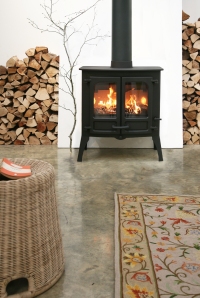We recommend regular maintenance of both fireplace and chimney. A clean fireplace provides for a great view of the fire and the wood burns better and cleaner. In addition, if you burn dry wood of good quality and ensure regular sweeping of your chimney, you minimise the risk of soot fires that can cause damage to the chimney. A proper maintenance system extends the lifetime for your stove and gives you many years of great experiences.
You can easily do the daily maintenance yourself – it does not require expensive equipment or special skills. In addition, according to Norwegian regulations, all fireplaces should be inspected and swept at least every four years. These inspections are performed by the local chimney sweep association. Here are some tips you might find useful.
Tip 1
Removing soot from the fireplace glass
A lot of stoves are made with a so-called air-wash system, which helps you keep the glass clean during burning. If soot covers the glass, it is normally enough to burn intensely for a short periods of time and the heat and the air-wash system will make sure that soot particles attached to the glass are burned off.
If the glass is still covered with soot, we recommend the following method: Moisten a wrinkled piece of newspaper and dip it carefully in the ashes on the bottom of the wood stove. Rub the paper against the glass with the ashes turned towards the glass. Repeat more times if necessary to loosen all of the soot. Finally, you dry off with a clean piece of paper to remove the soot particles that are now loose. This method is better for the environment, efficient and cheap.
Tip 2
Emptying the ashes
A lot of people clean out the ashes way too often. In fact, it is beneficial to leave a layer of ashes on the bottom of the fireplace. This layer insulates and protects the bottom and the floor underneath from the burning heat of the fire. Also, many people find that it is easier to light the fire if a few pieces of charcoal are left from earlier. Ashes are the non-flammable parts of the wood, mostly minerals.
Since ashes are an extremely insulating material, you often find small, glowing pieces hidden in the ashes hours or days after the fire is out. When you empty the ashes, it is therefore important that it is emptied in a bucket with a lid, both made of metal. This must be left until you are sure that there are no glowing bits left in the ashes. Ashes cannot be composted, but can be used as fertiliser if it stems from clean, untreated wood. Alternatively, it can be thrown out with other waste.
Tip 3
Annual maintenance of fireplaces and wood stoves
At least once a year, Jøtul recommends that you remove the baffle plate and burn plates to make sure that they are in good shape. They also suggest checking the riddling grate and bottom burn plate for damage. Brush off soot particles from these and the rest of the burn chamber. Internal parts also get worn, and should be replaced from time to time.
If and when depends on how hard and how much you use the fireplace. The gaskets around the glass and the door should also be checked and replaced if they are damaged.
Tip 4
Sweeping of the chimney and fireplace
We would recommend that the chimney is swept once a year.
A clean fireplace and a clean chimney is important to achieve an environmental combustion and avoid a soot fire that can damage the chimney and in the worst case scenario lead to a full-blown fire. Non-cleanburning fireplaces produce substantially more soot than modern, cleanburning wood stoves. Wet wood is another source of soot. In cases where the chimney sweep sees this, they will instruct you on the correct techniques and suggest measures to be put in place.
 Scottish Stove Centre
Scottish Stove Centre

